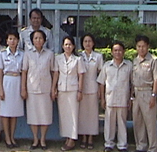การวิจัยนี้มีจุดประสงค์เพื่อ 1) เพื่อสร้างแผนการเรียนการสอนวรรณคดีไทย เรื่องรามเกียรติ์ ตอนศึกสายเลือด โดยการจัดการเรียนรู้แบบ ซิปปาโมเดล (CIPPA MODEL) ร่วมกับเกม ของนักเรียนชั้นประถมศึกษาปีที่ 6 และ 2) เพื่อเปรียบเทียบผลสัมฤทธิ์ก่อนและหลังการเรียนวรรณคดีไทย เรื่องรามเกียรติ์ ตอนศึกสายเลือด โดยการจัดการเรียนรู้แบบ ซิปปาโมเดล (CIPPA MODEL) ร่วมกับเกม ของนักเรียนชั้นประถมศึกษาปีที่ 6 และ 3) เพื่อศึกษาความพึงพอใจของของนักเรียนชั้นประถมศึกษาปีที่ 6 ที่มีต่อการจัดการเรียนรู้วรรณคดีไทย เรื่องรามเกียรติ์ ตอนศึกสายเลือด โดยการจัดการเรียนรู้แบบ ซิปปาโมเดล (CIPPA MODEL) ร่วมกับเกม ของนักเรียนชั้นประถมศึกษาปีที่ 6 กลุ่มตัวอย่าง ได้แก่ นักเรียนชั้นประถมศึกษาปีที่ 6/1 โรงเรียนบ้านคลองน้ำคัน อำเภอวังโป่ง จังหวัดเพชรบูรณ์ จำนวน 1 ห้อง จำนวน 12 คน ด้วยการสุ่มอย่างง่าย เครื่องมือที่ใช้ 1) แผนการเรียนการสอนวรรณคดีไทย เรื่องรามเกียรติ์ ตอนศึกสายเลือดโดยการจัดการเรียนรู้แบบ ซิปปาโมเดล (CIPPA MODEL) ร่วมกับเกมจำนวน 5 แผน 2) แบบทดสอบทางการเรียนเรื่องรามเกียรติ์ ตอนศึกสายเลือด เป็นชนิดปรนัยเลือกตอบ 4 ตัวเลือก 20 ข้อ และ 3) แบบสอบความความพึงพอใจของนักเรียนที่มีต่อการจัดการเรียนรู้ สถิติที่ใช้ ได้แก่ ค่าเฉลี่ย ร้อยละ ส่วนเบี่ยงเบนมาตรฐานการทดสอบ t-test dependent
ผลการวิจัยพบว่า 1. แผนการเรียนการสอนวรรณคดีไทย เรื่องรามเกียรติ์ ตอนศึกสายเลือด โดยการจัดการเรียนรู้แบบ ซิปปาโมเดล (CIPPA MODEL) ร่วมกับเกม ของนักเรียนชั้นประถมศึกษาปีที่ 6 อยู่ในระดับมากที่สุด (x ̅ = 4.70, S.D.=0.19)
2. ผลการทดสอบผลสัมฤทธิ์หลังการจัดการเรียนรู้แผนการเรียนการสอนวรรณคดีไทย เรื่องรามเกียรติ์ ตอนศึกสายเลือด โดยการจัดการเรียนรู้แบบ ซิปปาโมเดล (CIPPA MODEL) ร่วมกับเกม ของนักเรียนชั้นประถมศึกษาชั้นปีที่ 6 สูงกว่าก่อนเรียนอย่างมีนัยสำคัญทางสถิติที่ 0.5 3. นักเรียนมีความพึงพอใจของนักเรียนหลังการจัดการเรียนรู้อยู่ในระดับมาก (x ̅ = 4.45,S.D=0.67)
คำสำคัญ : ทักษะการคิดวิเคราะห์; สุนทรียสาธก; สื่อมัลติมีเดีย; บทละครพูดเรื่องเห็นแก่ลูก
ABSTRACTS
The objectives of this research were 1) to create a lesson plan in order to develop the critical skill in terms of drama dialog by using the Appreciative inquiry process and the multimedia for Mayattayom 3 level students 2) to compare the students critical skill before and after learning by the Appreciative inquiry and the multimedia. 3) to acknowledge the students satisfaction towards the learning plan by using the Appreciative inquiry process and the multimedia in order to develop the critical skill regarding the drama dialog Hen Kae Luk.
The samples of this research are Mayattayom 3 students at Chiang Mai University Demonstration School, Chiang Mai, Thailand. The research is conducted on the 2nd semester in 2021. There are 221 samples in 5 classes, which each room has 42 students by using a simple random sampling.
The research instrument consists of 1) 5 papers of the lesson plan by using the Appreciative inquiry process and multimedia 2) The multiple choice test on the critical reading on the drama dialog Hen Kae Luk . There are 40 questions with 4 choices. 3) the QA evaluation form towards the quality of the multimedia in the drama dialog Hen Kae Luk.4) The questionnaire towards the students satisfaction on their learning by using the Appreciative inquiry process and the multimedia. In terms of the analysis, the methods of statistics are implemented in this researchmean, percentage, the standard deviation, as well as T-test dependent.
It was found that 1) the lesson plan by using the Appreciative inquiry process and multimedia for Mattayom 3 students is in the excellent level. (x ̅ = 4.72, S.D=0.20)
2) Students critical skill after learning by using the Appreciative inquiry process and multimedia regarding the drama dialog Hen Kae Luk significantly increases comparing to before learning by 0.5 by a statistical calculation.
3) Students are satisfied with this learning method by applying the Appreciative inquiry process and multimedia regarding the drama dialog Hen Kae Luk with an excellent level of satisfaction. ( x ̅= 4.01,S.D=0.14)


 ค้นหาทุกอย่างในเว็บครูบ้านนอก :
ค้นหาทุกอย่างในเว็บครูบ้านนอก :































